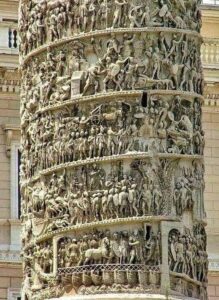Introduction
The Column of Marcus Aurelius, an iconic structure located in the heart of Rome, stands as a testament to the architectural and artistic prowess of the Roman Empire. Erected in the 2nd century AD, this monumental column commemorates the military achievements of Emperor Marcus Aurelius, providing a captivating glimpse into the past through its intricate carvings and historical significance.
Historical Context
Marcus Aurelius, a Stoic philosopher and Roman Emperor from 161 to 180 AD, is renowned for his leadership during a period marked by conflict and philosophical inquiry. The column was constructed around 193 AD, during the reign of his son, Commodus, to honor his father’s military campaigns against the Marcomanni and other tribes along the northern frontier. The column not only serves as a memorial but also as a political statement, reinforcing the legitimacy of Commodus’s rule through his father’s celebrated legacy.
Architectural Features
Standing approximately 30 meters tall, the Column of Marcus Aurelius is crafted from Carrara marble, showcasing the exceptional quality of Roman craftsmanship. Its design is inspired by the earlier Trajan’s Column, yet it features distinct characteristics that set it apart. The column’s base is adorned with a square pedestal, upon which the cylindrical shaft rises. The shaft is intricately carved with a continuous frieze that spirals around the column, depicting over 250 individual figures.

Artistic Analysis
The frieze on the Column of Marcus Aurelius presents a rich narrative of the emperor’s military campaigns, illustrating scenes of battle, victory, and the emperor’s interactions with his soldiers. The reliefs are characterized by a dynamic composition and a strong sense of movement, capturing the intensity of warfare. Unlike earlier columns, which often depicted more static scenes, the Column of Marcus Aurelius conveys a more emotional and humanistic approach, highlighting the struggles and valor of both the soldiers and the emperor himself.
One of the most notable aspects of the frieze is its emphasis on realism. The figures are depicted with a high degree of detail, showcasing individual expressions and the unique characteristics of various ethnic groups involved in the conflicts. This focus on realism reflects the broader trends in Roman art during the 2nd century, where artists sought to capture the complexities of human experience.

Symbolism and Significance
Beyond its artistic merit, the Column of Marcus Aurelius serves as a powerful symbol of the virtues that the emperor embodied: duty, bravery, and philosophical contemplation. As a Stoic philosopher, Marcus Aurelius believed in the importance of reason and virtue, themes that resonate throughout the column’s imagery. The depiction of the emperor leading his troops not only reinforces his role as a military leader but also highlights his commitment to the well-being of the Roman state.
Additionally, the column has become a symbol of resilience and strength, representing the challenges faced by the Roman Empire during a time of external threats. It stands as a reminder of the enduring legacy of Roman culture and its influence on subsequent generations.

Conclusion
The Column of Marcus Aurelius is more than just an architectural landmark; it is a narrative monument that encapsulates the history, art, and philosophy of the Roman Empire. Through its detailed carvings and thoughtful design, the column continues to inspire admiration and intrigue, offering a profound connection to a pivotal era in ancient history. As we gaze upon this magnificent structure, we are reminded of the complexities of leadership, the human spirit, and the artistic achievements that define our cultural heritage.
